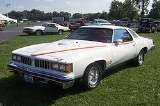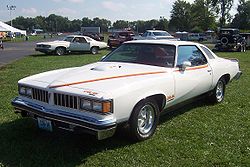
Pontiac Can Am
Encyclopedia

Mid-size car
A mid-size car is the North American/Australian standard for an automobile with a size equal to or greater than that of a compact...
muscle car based on the LeMans
Pontiac LeMans
The Pontiac LeMans was a model name applied to compact and intermediate-sized automobiles offered by the Pontiac division of General Motors from 1962 to 1981. The LeMans was replaced by the downsized Pontiac Bonneville for the 1982 model year...
. It was a special edition option package, and was only available in 1977.
Background
It was introduced midway through the production year, at the North American International Auto ShowNorth American International Auto Show
The North American International Auto Show is an annual auto show held in Detroit, Michigan at Cobo Center, usually in January. It is among the largest auto shows in North America.-History:...
at the Detroit Auto Show during January 1977 - along with the Pontiac Sunbird
Pontiac Sunbird
The Pontiac Sunbird, produced by the Pontiac division of General Motors, was Pontiac's second small-car offering of the 70's. The Sunbird model ran for 18 years and was then replaced in 1995 by the Pontiac Sunfire...
Sport Hatch model. The Can Am was available with two engines, both with the Trans Am's
Pontiac Firebird
The Pontiac Firebird was built by the Pontiac division of General Motors between 1967 and 2002. The Firebird was introduced the same year as the automaker's platform-sharing model, the Chevrolet Camaro...
shaker hood scoop
Shaker scoop
A shaker scoop is an automobile term for an air intake for combustion air that is mounted directly on top of the engine's air cleaner and protrudes through a hole in the hood...
as standard equipment. The standard engine was the Pontiac 400 making 200 hp (the T/A 6.6 "W72" version, not the base 400, which made 180). The other available engine, (the only one available in California and high-altitude areas) was the Oldsmobile 403 Small Block making 185 hp. The Can Am package also included a "duck-tail" spoiler, Cameo White paint and striking orange, red and yellow graphics as well as blacked-out lower panels and window trim. The standard wheel was a color-matched Rally II with chrome trim rings, as shown at right. Many options were available, including the same aluminum "snowflake" wheels offered on the Trans Am, and a steel or glass sunroof. Interior color options were the same as the base LeMans, and included red, black, white and tan.
Production
The number of Can Ams produced has never been accurately determined, but the number most commonly used is 1,377. According to the Can Am Registry in late 2007, 42 have the Oldsmobile 403 engine. The rest of the cars on the Registry have the Pontiac 400 "T/A 6.6" engine. The Pontiac Historical Service (PHS) can determine whether a car is a genuine Can Am, and list the options as it was delivered from the factory.When the Can Am was first introduced to the dealers, Pontiac envisioned producing 2,500 units; the response from the buying public was much more than expected and over 5,000 orders were submitted. Unfortunately, the mold used to produce the fiberglass rear spoiler broke, and production at Motortown, Inc. (where the LeMans Sport Coupes destined to become Can Ams were sent) ceased. Pontiac upper management, already worried about losing sales of their Grand Prix models (the Can Am and the Grand Prix used the same dashboard and console, so a sale of a Can Am was seen as a loss of a sale of a Grand Prix by some senior Pontiac executives), decided to scrap the project after approximately one half year of production.
There have been some pervasive myths or urban legends regarding the Can Am. It was only available in Cameo White paint, and not any other color from the factory - such as Mandarin Orange or Carousel Red. This rumor continues, despite the facts being well documented via discussions with Jim Wangers, the motivating force behind Motortown. Performance tests back in 1977 were also confusing. Road tests commonly quoted the Can Am as having a 180 hp Pontiac 400, along with a 2.41 rear gear ratio. This was a combination never offered to the public. When built with the Pontiac 400, the Can Am came with the three speed automatic TH400 and 3.08 rear gears. When built with the Olds 403 engine, the Can Am came with the three speed automatic TH350 and 2.41 rear gears. There were no four speed Can Ams produced. However, one Can Am has been restored and modified with a conversion to a Super T10 manual transmission using all-GM factory parts, from various years of the 73-77 GM A-body.
Performance tests from 1977 estimated 0-60 mph time for the Can Am with the Pontiac engine at about 10 seconds flat, about the same as the previous year's LeMans with the 455, and a 1/4 mile time of approximately 17 seconds. However, the Pontiac 400 is an excellent base for tuning and rebuilding for higher performance. Simple changes, such as a switch to a 3.42 rear gearset, dual exhaust, an "068" grind cam and an earlier Pontiac intake manifold will make a significant improvement in performance.

